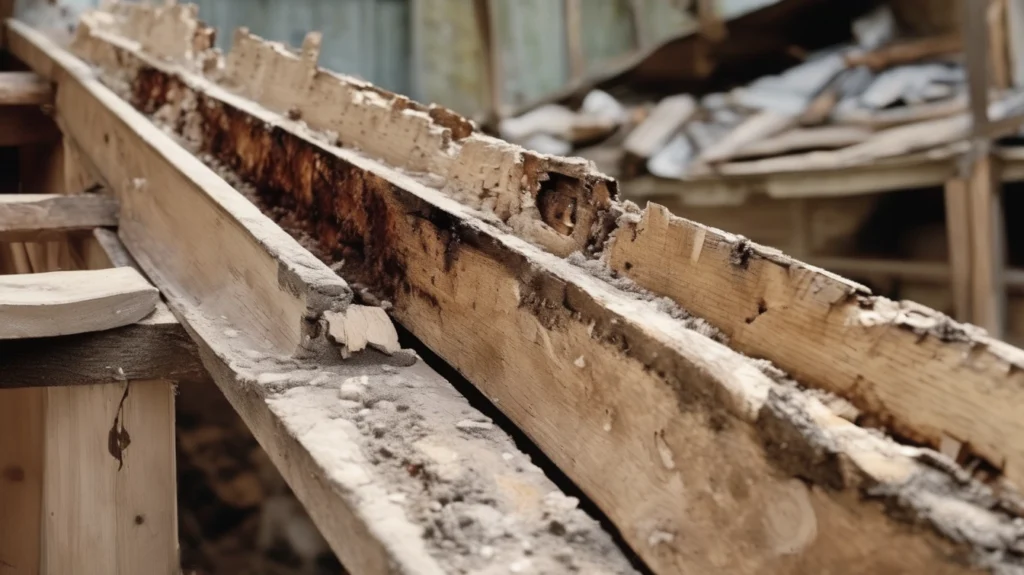Introduction
If you’ve ever found a sprinkling of fine dust beneath a timber beam or noticed small round holes peppering the surface of a wooden chair, you may have unwittingly discovered woodworm. Many homeowners feel a pang of dread at the thought of creepy crawlies munching through their floorboards, or fungus silently destroying a staircase. I remember helping a friend renovate an old cottage in Surrey: we pulled up the hallway carpet and were greeted by a lattice of tiny tunnels where a beetle had made itself at home. With damp British weather and historic housing stock, these issues are common across London, Surrey and Berkshire. This article demystifies woodworm, wet rot and dry rot, explains how to spot them and outlines treatment options.
Woodworm – The common furniture beetle
In the UK, the majority of insect-related timber damage is caused by Anobium punctatum, more commonly known as the common furniture beetle. Despite its name, this tiny brown insect rarely attacks modern furniture; it prefers older timbers that have been dead for years and can still infest sapwood and heartwood. Adults measure around 4–6 mm long and leave tell‑tale 1–2 mm diameter holes when they emerge. The real destruction happens during the larval stage, when the grub tunnels through wood for several years, leaving behind a fine, gritty dust known as frass. Because the larvae spend their lives hidden, many homes are treated pre‑emptively: historically, mortgage lenders even required woodworm treatments before approving loans.
Signs of woodworm
Look for small exit holes with fresh, light‑coloured edges; a powdery dust nearby; and weak or crumbly timber. In severe cases, floorboards may sag or break underfoot. Sometimes infestation only becomes apparent when you sand or plane a timber and reveal the tunnels beneath the surface. Don’t panic if you find isolated holes in antique furniture—many beetles have a short life cycle and may already be long gone—but any sign in structural timbers warrants investigation.
Treatment options
If infestation is active, the affected timber may need replacing or impregnating with a residual insecticide by a professional. Some specialists use boron-based treatments, which penetrate deeply and provide long‑lasting protection. The British Pest Control Association recommends asking for a timber survey to assess the extent of damage before deciding on chemical treatment. After treatment, ensure humidity levels remain low to discourage re‑infestation.
Wet rot – Fungus thrives on damp timber
Wet rot isn’t a single organism but a group of fungi that thrive on persistently damp wood. The most common species is Coniophora puteana, also known as cellar fungus. When unprotected timber absorbs moisture from leaks, blocked gutters or poor ventilation, fungi feed on the cellulose and lignin, causing darkening, softening, cracking and a musty smell. Wet rot tends to stay localised to the damp area, but it still weakens timber and can spread to plaster, wallpaper or carpets.

Spotting wet rot
Look for timber that is darker than surrounding wood, soft and spongy to the touch or showing a cracked surface. Damaged paintwork, shrinking wood and a damp, earthy odour are also clues. Wet rot often affects skirting boards in bathrooms, window frames and cellar beams. Because its symptoms can mimic dry rot, professional assessment is recommended.
Treating and preventing wet rot
The priority is stopping the moisture source—repair leaking gutters, fix roofs and improve ventilation. Once the timber is dry, affected sections may need removal and replacement. Remaining wood should be treated with a fungicide to stop residual spores. Re‑paint or seal exposed wood, and keep humidity levels below 20 per cent to discourage future growth. Dehumidifiers and positive‑input ventilation systems can help regulate indoor moisture.
Dry rot – A more serious fungal threat
Dry rot (Serpula lacrymans) is the most serious form of fungal decay. Unlike wet rot, it produces its own moisture as it digests timber, allowing it to spread through brickwork and masonry. It prefers timber with around 20 per cent moisture, so underlying damp issues often trigger an outbreak. Dry rot progresses through spores, hyphae and mycelium, eventually forming pancake‑like fruiting bodies that release red dust. Left unchecked, it can cause structural collapse.
Identifying dry rot
Early signs include fine white strands of mycelium spreading across timber and a cotton‑wool‑like substance behind skirting boards. The wood may crack into cube‑shaped pieces (cuboidal cracking) and feel brittle. Fruiting bodies appear as fleshy, mushroom‑like growths with an orange rim. Dry rot often emits an earthy, mushroom‑like smell and can travel through plaster and brick to reach other timbers.
Treating dry rot
Because dry rot can migrate through walls, treatment requires isolating the affected area, removing and burning all infected timber, sterilising masonry and ensuring the building is thoroughly dried. A professional may apply a fungicidal paste or inject preservative into masonry. It’s essential to address the moisture source—fix leaks, improve ventilation and use dehumidifiers. In severe cases, structural timbers must be replaced, and remedial damp-proof courses may be installed.
DIY vs professional help
While DIY treatments exist for minor woodworm and wet rot, dry rot almost always needs expert intervention due to its aggressive spread. An experienced surveyor will identify the type of decay, recommend appropriate products and provide a guarantee. Choosing a local company, such as GO2 Property Services, ensures understanding of local building types and climate, as well as quick response times. Maintaining healthy timbers
Prevention is always cheaper than cure. Keep your property well ventilated, ensure external ground levels don’t bridge damp-proof courses, and maintain gutters and roof coverings. If you notice unexplained damp patches or musty smells, investigate promptly. When renovating older homes, ask for a timber survey to catch issues early. By understanding the signs of woodworm, wet rot and dry rot and acting quickly, you can protect your property’s structural integrity and avoid costly repairs.